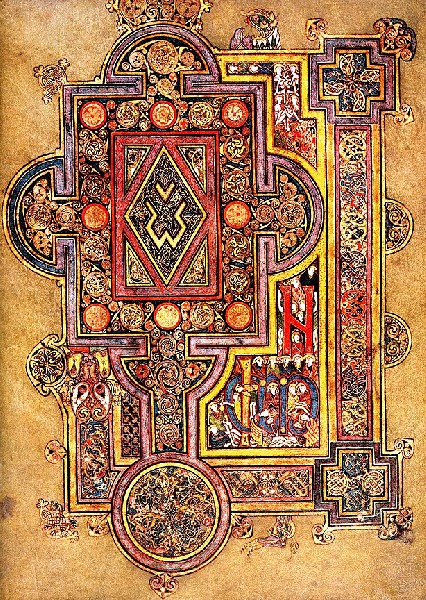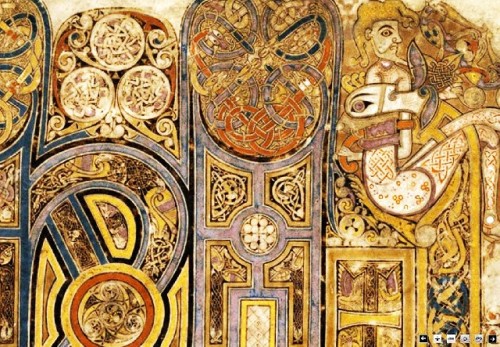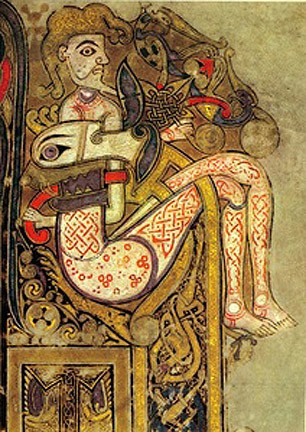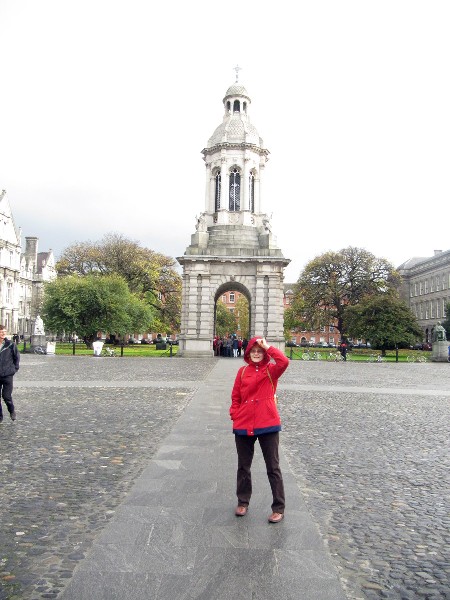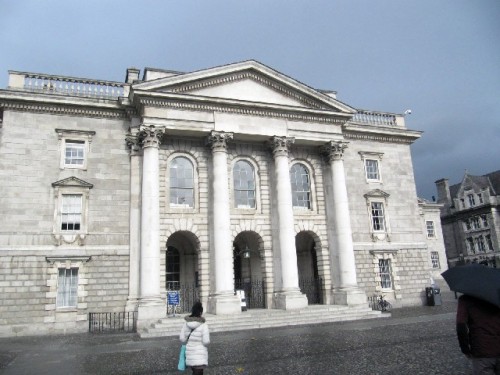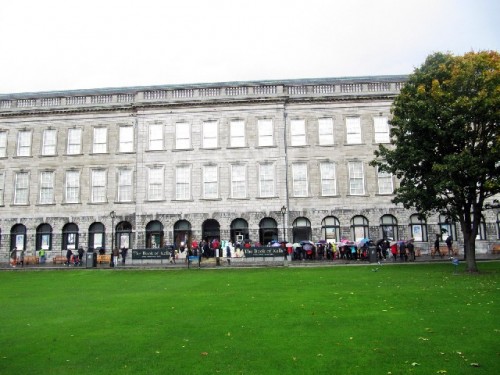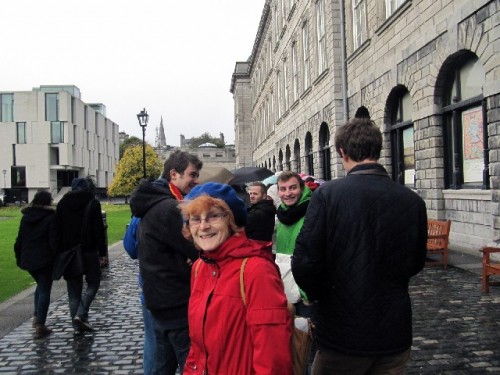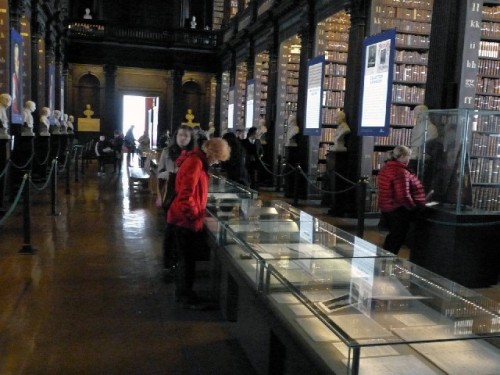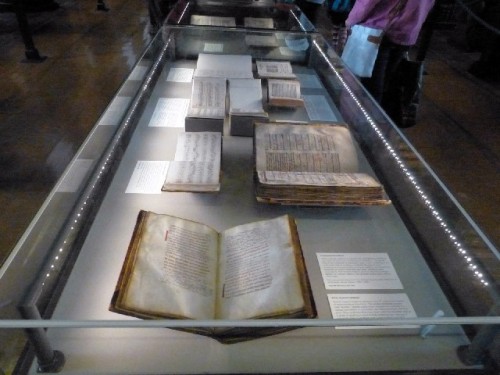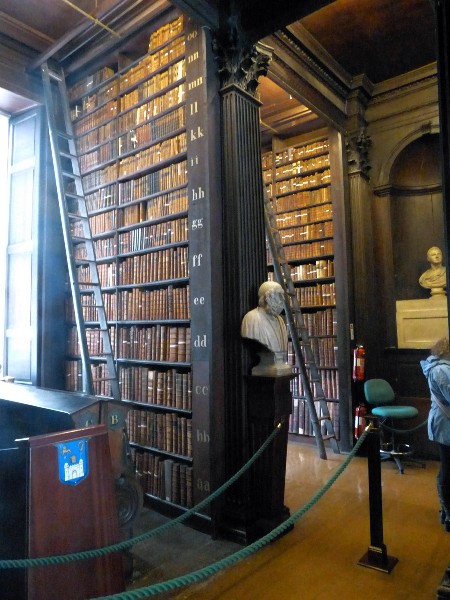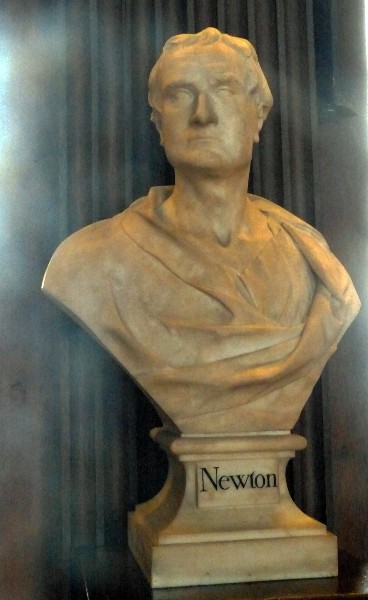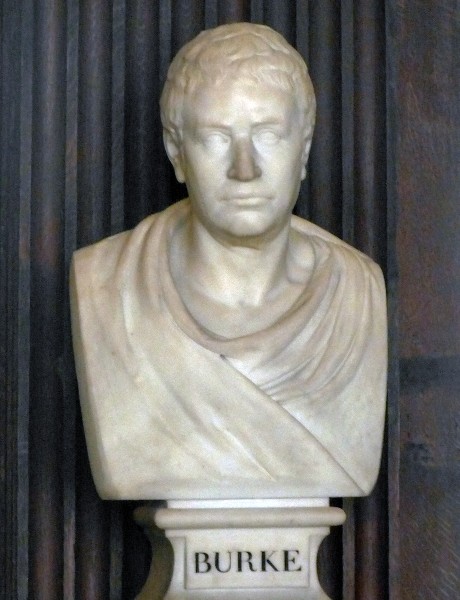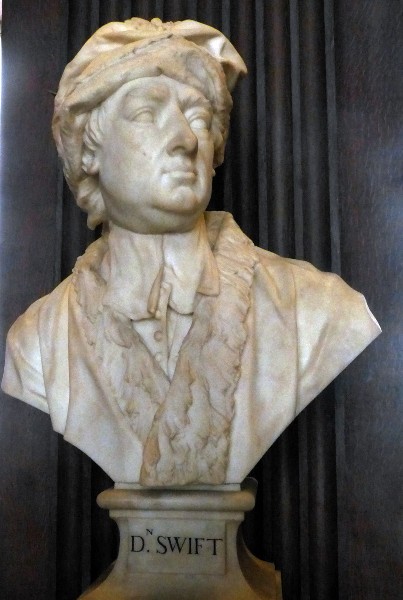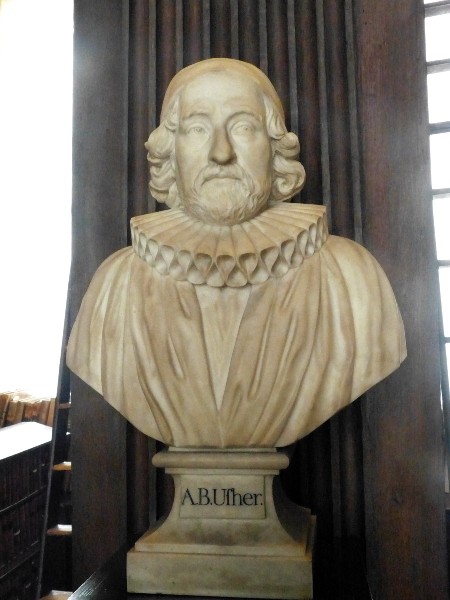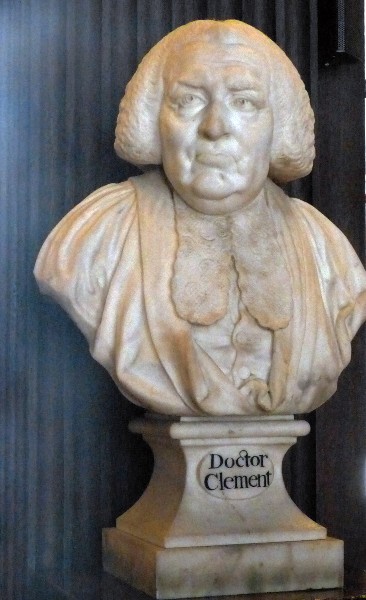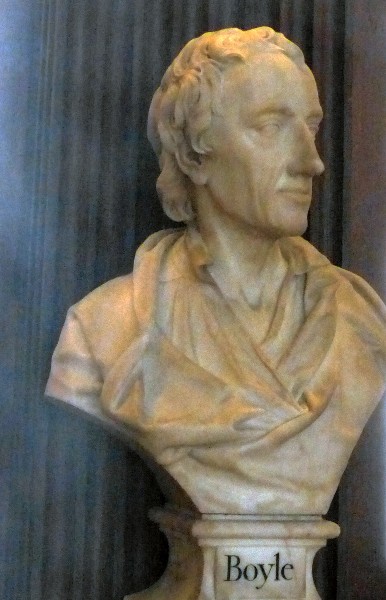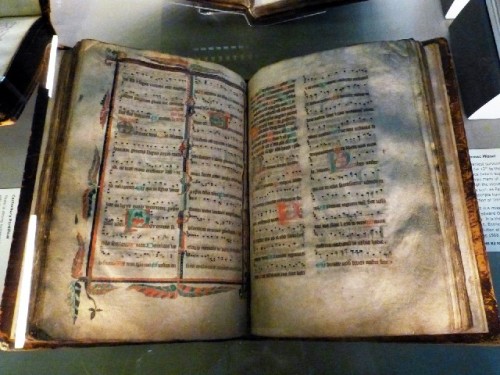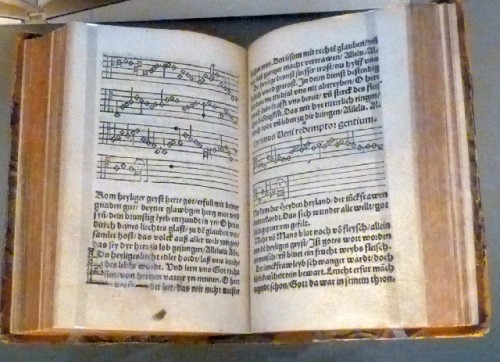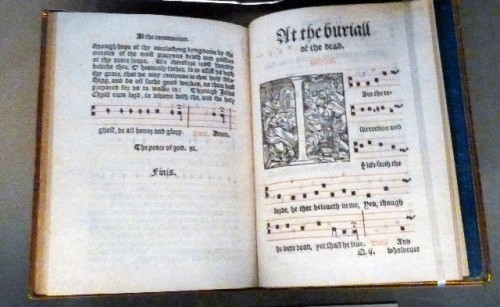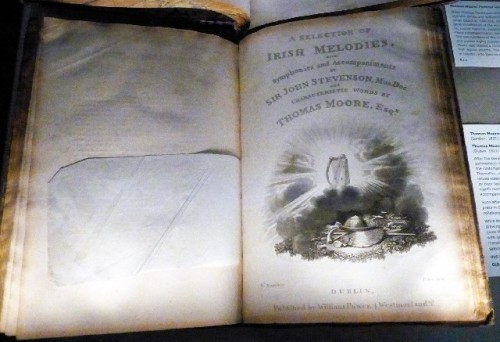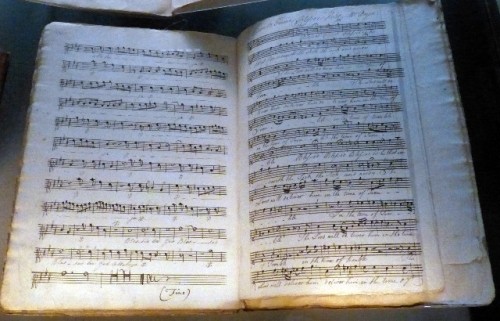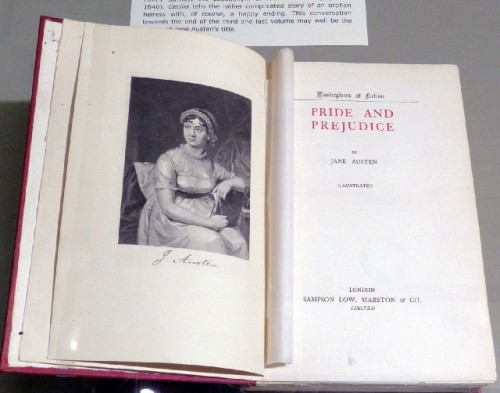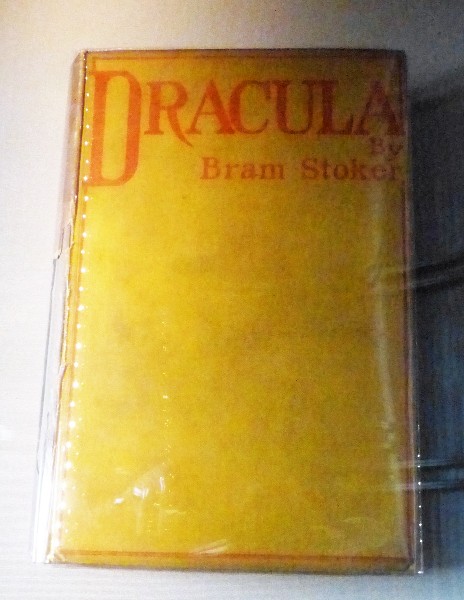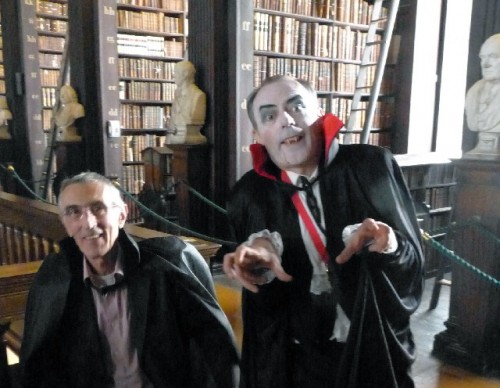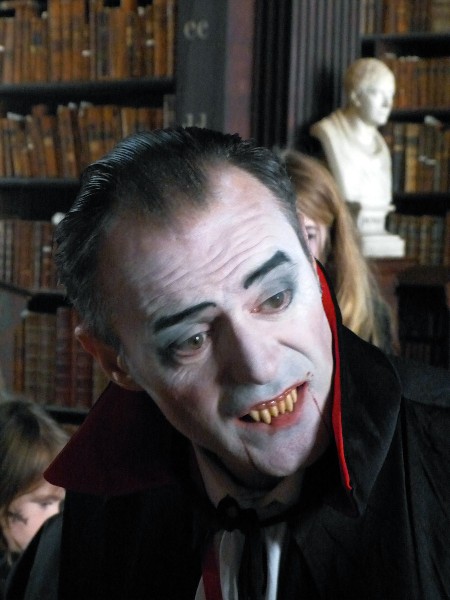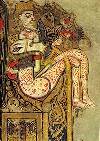Trinity College and the Book of Kells
Viewing Ireland's National Treasures
By: Charles Giuliano - Dec 03, 2013
Treasures of Early Irish Art traveled to American museums for two years. Comprising works from the National Museum of Ireland, the Royal Irish Academy, and Trinity College, Dublin. It was curated by David DuBon.
When the exhibition opened in 1979 at the Museum of Fine Arts, Boston I was fortunate to attend the press opening. Even compared to the crush of later visitors one managed but a few moments to view each of the medieval manuscripts including the greatest national treasure of Ireland, The Book of Kells.
The exhibition was installed in such a manner that the final gallery, with the books, was all but pitch dark. There was a queue inching past the vitrines which were illuminated at one candle power. One was pressed on by those behind eager for a glimpse of the legendary treasures.
During our recent visit to Dublin I spent a few minutes more with the display of several medieval books in the old library of Trinity College. The experience was still relatively brief but not as frenzied as it had been in Boston.
Arriving off season in late October the line, which took about a half hour, was not what one encounters during peak summer tourism.
Before actually entering the gallery there is an excellent display with enlargements of intricate details of the book which are difficult to study in dim light with the naked eye. There was accompanying text discussing the complex iconography as well as illustrations of all of the elements entailed in creating the manuscripts from materials and tools to techniques.
Before Marco Polo (c.1254 – January 8–9, 1324) returned from China with the technique of paper making the support for writing and hand made books was vellum. This organic material, which has proven to be remarkably durable, was processed from calf or sheep skin. This entailed inconsistencies which were documented in the Trinity exhibition.
Prior to Johannes Gensfleisch zur Laden zum Gutenberg (1395 – February 3, 1468), who invented printing with moveable type around 1439, Bibles were created by hand. Nothing was more valuable than the word of God. Books were essential to monasteries which became the first centers for learning and the founding of universities.
In order to perform a mass or preach the Gospels priests were required to read Latin and even Greek. They in turn were charged with instructing the nobility. Though fluent in several languages Einhard, in his The Life of Charlamagne, tells us that the Holy Roman Emperor practiced his letters but remained illiterate.
The first book printed by Guttenberg on more affordable paper was The Bible. While even these first printed books were relatively scarce they greatly increased literacy in Europe. This was crucial to the protestant reformation founded by Martin Luther (10 November 1483 – 18 February 1546).
While in hiding from reprisals of Pope Leo X Luther translated the Bible into vulgate German. When printed and made more widely accessible Luther argued that you did not need the priests or corrupt hierarchy of the Roman Catholic Church to speak directly to God.
Before Guttenberg, Luther, the Reformation and the rise of literacy priests and the Church were the gatekeepers to Heaven.
Once complied and edited by Saint Jerome (c. 347 – 30 September 420) into the four Gospels of Matthew, Luke, Mark and John the Bible was the literal word of God and must be copied verbatim. Which for centuries the monks did by hand.
When the reformation came to England it was necessary to have an English translation of The New Testament.
The King James Version (KJV), commonly known as the Authorized Version (AV) or King James Bible (KJB), for the Church of England was begun in 1604 and completed in 1611. It was the third translation into English to be approved by the English Church authorities. The first was the Great Bible commissioned in the reign of King Henry VIII, and the second was the Bishops' Bible of 1568. In January 1604, King James I convened the Hampton Court Conference.
The new version conformed to the ecclesiology and reflected the episcopal structure of the Church of England and its belief in an ordained clergy. The translation was done by 47 scholars, all of whom were members of the Church of England. In common with most other translations of the period, the New Testament was translated from Greek, the Old Testament was translated from Hebrew text, while the Apocrypha were translated from the Greek and Latin. In the Book of Common Prayer (1662), the text of the Authorized Version replaced the text of the Great Bible – for Epistle and Gospel readings – and as such was authorized by Act of Parliament.
As an undergraduate I participated in the seminar on medieval manuscripts by Joachim Gaehde (later Dean Gaehde of Brandeis University). We studied Carolingian illuminated manuscripts both through slides and magnificent facsimile publications. We have learned that recently he passed away at 92 on November 24. Decades later I vividly recall his inspiring passion for the material.
Perhaps that was an aspect of why the recent brief encounter at Trinity College was so deeply emotional. And why these few books are aptly described as a part of the greatest cultural legacy of the Irish people and the heritage of my own family.
It has long been unfathomable to me that the monks were able to devote a good portion of their lives to the meticulous, hard to see, knotted and gnarled tangles of the word of God. Of course that also applies to the scribes of Torah or the creators of Qur’an. In our digital age it is difficult to comprehend such total faith and surrender of self to God’s work.
At Trinity we learned and were shown examples of the three hands that scholars believe were involved in creating the Book of Kells. It was fascinating to discover that they made mistakes and how they concealed them.
It is believed that the Anglo Irish manuscripts were created between the 7th and 9th centuries. Scholars date The Book of Kells to ca. 800. So called because it was owned by if not made in the Monastery of Kells. When Oliver Cromwell invaded Ireland it was sent to Dublin for safe keeping and eventually made its way to Trinity College.
During the medieval period Ireland was constantly raided and looted by Vikings. Then, for more centuries, it was besieged by the British. It is a wonder that such precious books survived.
The Book of Kells contains the four Gospels written in black, red, purple, and yellow ink in an insular majuscule script, preceded by prefaces, summaries, and concordances of Gospel passages.
Today, it consists of 340 vellum leaves, or folios. The majority of the folios are part of larger sheets, called bifolios, which are folded in half to form two folios. The bifolios are nested inside of each other and sewn together to form gatherings called quires. On occasion, a folio is not part of a bifolio but is instead a single sheet inserted within a quire. The extant folios are gathered into 38 quires.
There are between four and twelve folios (two to six bifolios) per quire; the folios are commonly, but not invariably, bound in groups of ten. Some folios are single sheets, as is frequently the case with decorated pages. The folios had lines drawn for the text, sometimes on both sides, after the bifolios were folded. Prick marks and guide lines can still be seen on some pages. The vellum is of high quality, although the folios have an uneven thickness, with some being close to leather while others are so thin as to be almost translucent.
The book's current dimensions are 330 by 250 mm. Originally, the folios were of no standard size, but they were cropped to the current size during a 19th-century rebinding. The text area is approximately 250 by 170 mm. Each text page has 16 to 18 lines of text. The manuscript is in remarkably good condition though many pages have suffered some damage.
The book must have been the product of a major scriptorium over several years, yet was apparently never finished, the projected decoration of some of the pages appearing only in outline. It is believed that some 30 folios of the original manuscript have been lost over the centuries.
With poignant reluctance we left the gallery of books and ascended to the old music library above. This was a different but truly magnificent experience.
One imagined scholars over the centuries at work in such a wonderful environment.
The bays flanked around the natural light of large windows contained the stacks of ancient volumes. Some of these treasures were displayed in vitrines that ran the length of the central aisle.
It was interesting to learn that the music library continues to compile contemporary materials. It was fun to discover U2, arguably Ireland’s most famous living musicians.
Being around Halloween there was an ersatz Count Dracula haunting the library. I hadn’t realized that Bram Stoker (8 November 1847 – 20 April 1912) was an Irish author. We gazed upon an 1897 first edition of his canonical novel Dracula.
Indeed we were completely spooked when we made our way out of Trinity College during a soft Irish mist.


